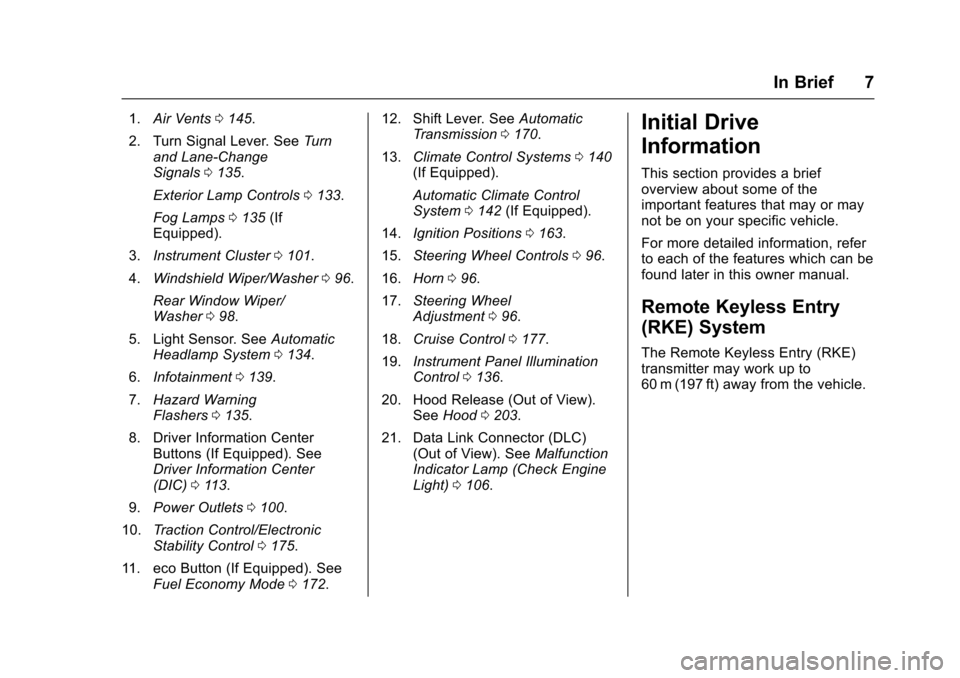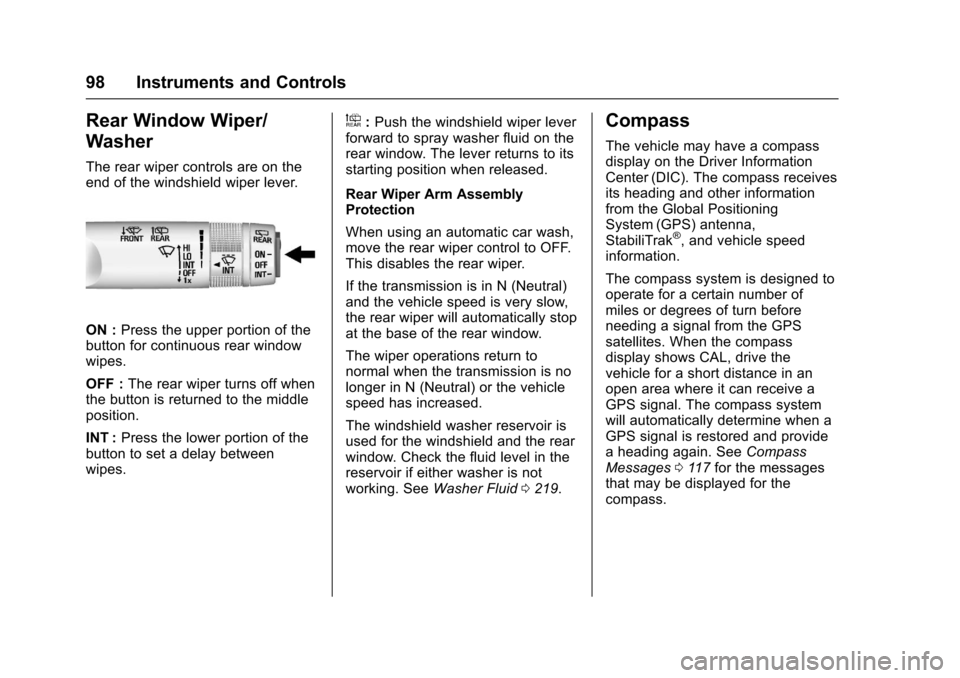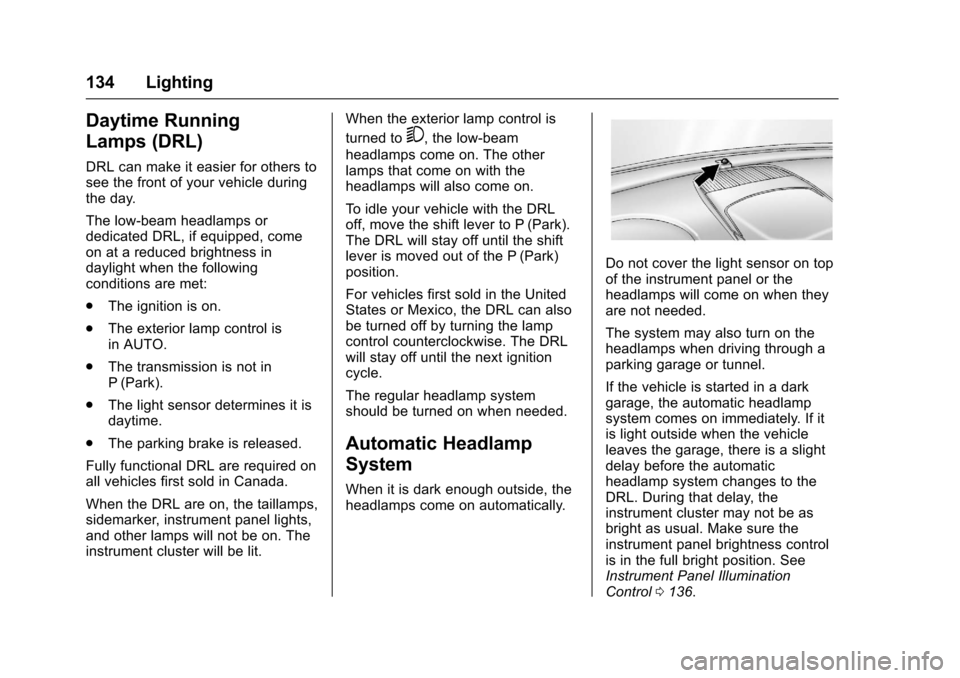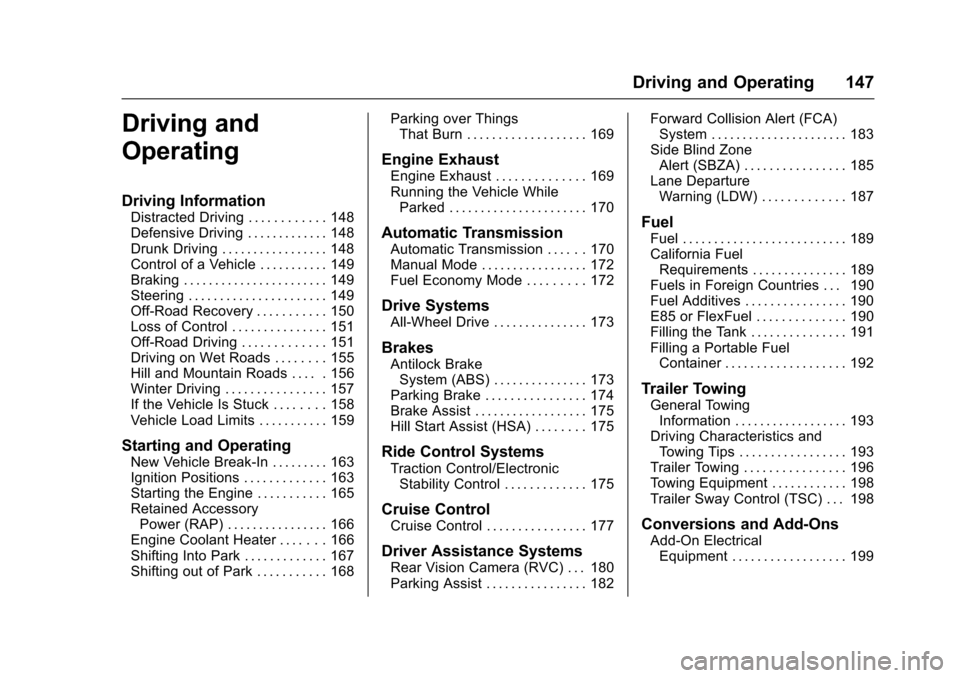2017 CHEVROLET EQUINOX automatic transmission
[x] Cancel search: automatic transmissionPage 8 of 327

Chevrolet Equinox Owner Manual (GMNA-Localizing-U.S./Canada/Mexico-
9918169) - 2017 - CRC - 3/23/16
In Brief 7
1.Air Vents 0145.
2. Turn Signal Lever. See Turn
and Lane-Change
Signals 0135.
Exterior Lamp Controls 0133.
Fog Lamps 0135 (If
Equipped).
3. Instrument Cluster 0101.
4. Windshield Wiper/Washer 096.
Rear Window Wiper/
Washer 098.
5. Light Sensor. See Automatic
Headlamp System 0134.
6. Infotainment 0139.
7. Hazard Warning
Flashers 0135.
8. Driver Information Center Buttons (If Equipped). See
Driver Information Center
(DIC) 0113.
9. Power Outlets 0100.
10. Traction Control/Electronic
Stability Control 0175.
11. eco Button (If Equipped). See Fuel Economy Mode 0172. 12. Shift Lever. See
Automatic
Transmission 0170.
13. Climate Control Systems 0140
(If Equipped).
Automatic Climate Control
System 0142 (If Equipped).
14. Ignition Positions 0163.
15. Steering Wheel Controls 096.
16. Horn 096.
17. Steering Wheel
Adjustment 096.
18. Cruise Control 0177.
19. Instrument Panel Illumination
Control 0136.
20. Hood Release (Out of View). SeeHood 0203.
21. Data Link Connector (DLC) (Out of View). See Malfunction
Indicator Lamp (Check Engine
Light) 0106.Initial Drive
Information
This section provides a brief
overview about some of the
important features that may or may
not be on your specific vehicle.
For more detailed information, refer
to each of the features which can be
found later in this owner manual.
Remote Keyless Entry
(RKE) System
The Remote Keyless Entry (RKE)
transmitter may work up to
60 m (197 ft) away from the vehicle.
Page 18 of 327

Chevrolet Equinox Owner Manual (GMNA-Localizing-U.S./Canada/Mexico-
9918169) - 2017 - CRC - 3/23/16
In Brief 17
Automatic Climate Control System
1. Fan Control
2. AUTO (Automatic Operation)
3. Air Delivery Mode Controls
4. Front Defrost
5. Recirculation
6. Temperature Control
7. A/C (Air Conditioning) 8. Driver and Passenger Heated
Seats (If Equipped)
9. Rear Window Defogger
10. Power
See Climate Control Systems 0140
(If Equipped) or Automatic Climate
Control System 0142 (If Equipped).
Transmission
Electronic Range Select
(ERS) Mode
ERS or manual mode allows for the
selection of the range of gear
positions. Use this mode when
driving downhill or towing a trailer to
limit the top gear and vehicle speed.
To use this feature:
1. Move the shift lever to M (Manual Mode).
2. Press the plus/minus button on the shift lever to increase or
decrease the gear range
available.
See Manual Mode 0172.
Page 32 of 327

Chevrolet Equinox Owner Manual (GMNA-Localizing-U.S./Canada/Mexico-
9918169) - 2017 - CRC - 3/23/16
Keys, Doors, and Windows 31
Power Door Locks
Q:Press to lock the doors.
K:Press to unlock the doors.
Delayed Locking
This feature delays the locking of
the doors until five seconds after all
doors are closed.
When
Qis pressed on the power
door lock switch while the door is
open, a chime will sound three
times indicating delayed locking is
active. The doors will lock automatically
five seconds after all doors are
closed. If a door is reopened before
that time, the five-second timer will
reset when all doors are closed
again.
Press
Qon the door lock switch
again or press
Qon the RKE
transmitter to lock the doors
immediately.
This feature can also be
programmed. See Vehicle
Personalization 0123.
Automatic Door Locks
The doors will lock automatically
when all doors are closed, the
ignition is on, and the vehicle is
shifted out of P (Park).
To unlock the doors:
.
Press
Kon the power door lock
switch.
. Shift the transmission into
P (Park). Automatic door locking cannot be
disabled. Automatic door unlocking
can be programmed. See
Vehicle
Personalization 0123.
Lockout Protection
When locking is requested with the
driver door open and the key in the
ignition, all the doors will lock and
then the driver door will unlock.
This can be manually overridden by
pressing and holding
Qon the
power door lock switch.
Safety Locks
The rear door safety locks prevent
passengers from opening the rear
doors from inside the vehicle.
Page 99 of 327

Chevrolet Equinox Owner Manual (GMNA-Localizing-U.S./Canada/Mexico-
9918169) - 2017 - CRC - 3/23/16
98 Instruments and Controls
Rear Window Wiper/
Washer
The rear wiper controls are on the
end of the windshield wiper lever.
ON :Press the upper portion of the
button for continuous rear window
wipes.
OFF : The rear wiper turns off when
the button is returned to the middle
position.
INT : Press the lower portion of the
button to set a delay between
wipes.
a: Push the windshield wiper lever
forward to spray washer fluid on the
rear window. The lever returns to its
starting position when released.
Rear Wiper Arm Assembly
Protection
When using an automatic car wash,
move the rear wiper control to OFF.
This disables the rear wiper.
If the transmission is in N (Neutral)
and the vehicle speed is very slow,
the rear wiper will automatically stop
at the base of the rear window.
The wiper operations return to
normal when the transmission is no
longer in N (Neutral) or the vehicle
speed has increased.
The windshield washer reservoir is
used for the windshield and the rear
window. Check the fluid level in the
reservoir if either washer is not
working. See Washer Fluid 0219.Compass
The vehicle may have a compass
display on the Driver Information
Center (DIC). The compass receives
its heading and other information
from the Global Positioning
System (GPS) antenna,
StabiliTrak
®, and vehicle speed
information.
The compass system is designed to
operate for a certain number of
miles or degrees of turn before
needing a signal from the GPS
satellites. When the compass
display shows CAL, drive the
vehicle for a short distance in an
open area where it can receive a
GPS signal. The compass system
will automatically determine when a
GPS signal is restored and provide
a heading again. See Compass
Messages 0117 for the messages
that may be displayed for the
compass.
Page 135 of 327

Chevrolet Equinox Owner Manual (GMNA-Localizing-U.S./Canada/Mexico-
9918169) - 2017 - CRC - 3/23/16
134 Lighting
Daytime Running
Lamps (DRL)
DRL can make it easier for others to
see the front of your vehicle during
the day.
The low-beam headlamps or
dedicated DRL, if equipped, come
on at a reduced brightness in
daylight when the following
conditions are met:
.The ignition is on.
. The exterior lamp control is
in AUTO.
. The transmission is not in
P (Park).
. The light sensor determines it is
daytime.
. The parking brake is released.
Fully functional DRL are required on
all vehicles first sold in Canada.
When the DRL are on, the taillamps,
sidemarker, instrument panel lights,
and other lamps will not be on. The
instrument cluster will be lit. When the exterior lamp control is
turned to
5, the low-beam
headlamps come on. The other
lamps that come on with the
headlamps will also come on.
To idle your vehicle with the DRL
off, move the shift lever to P (Park).
The DRL will stay off until the shift
lever is moved out of the P (Park)
position.
For vehicles first sold in the United
States or Mexico, the DRL can also
be turned off by turning the lamp
control counterclockwise. The DRL
will stay off until the next ignition
cycle.
The regular headlamp system
should be turned on when needed.
Automatic Headlamp
System
When it is dark enough outside, the
headlamps come on automatically.
Do not cover the light sensor on top
of the instrument panel or the
headlamps will come on when they
are not needed.
The system may also turn on the
headlamps when driving through a
parking garage or tunnel.
If the vehicle is started in a dark
garage, the automatic headlamp
system comes on immediately. If it
is light outside when the vehicle
leaves the garage, there is a slight
delay before the automatic
headlamp system changes to the
DRL. During that delay, the
instrument cluster may not be as
bright as usual. Make sure the
instrument panel brightness control
is in the full bright position. See
Instrument Panel Illumination
Control 0136.
Page 148 of 327

Chevrolet Equinox Owner Manual (GMNA-Localizing-U.S./Canada/Mexico-
9918169) - 2017 - CRC - 3/23/16
Driving and Operating 147
Driving and
Operating
Driving Information
Distracted Driving . . . . . . . . . . . . 148
Defensive Driving . . . . . . . . . . . . . 148
Drunk Driving . . . . . . . . . . . . . . . . . 148
Control of a Vehicle . . . . . . . . . . . 149
Braking . . . . . . . . . . . . . . . . . . . . . . . 149
Steering . . . . . . . . . . . . . . . . . . . . . . 149
Off-Road Recovery . . . . . . . . . . . 150
Loss of Control . . . . . . . . . . . . . . . 151
Off-Road Driving . . . . . . . . . . . . . 151
Driving on Wet Roads . . . . . . . . 155
Hill and Mountain Roads . . . . . 156
Winter Driving . . . . . . . . . . . . . . . . 157
If the Vehicle Is Stuck . . . . . . . . 158
Vehicle Load Limits . . . . . . . . . . . 159
Starting and Operating
New Vehicle Break-In . . . . . . . . . 163
Ignition Positions . . . . . . . . . . . . . 163
Starting the Engine . . . . . . . . . . . 165
Retained AccessoryPower (RAP) . . . . . . . . . . . . . . . . 166
Engine Coolant Heater . . . . . . . 166
Shifting Into Park . . . . . . . . . . . . . 167
Shifting out of Park . . . . . . . . . . . 168 Parking over Things
That Burn . . . . . . . . . . . . . . . . . . . 169
Engine Exhaust
Engine Exhaust . . . . . . . . . . . . . . 169
Running the Vehicle WhileParked . . . . . . . . . . . . . . . . . . . . . . 170
Automatic Transmission
Automatic Transmission . . . . . . 170
Manual Mode . . . . . . . . . . . . . . . . . 172
Fuel Economy Mode . . . . . . . . . 172
Drive Systems
All-Wheel Drive . . . . . . . . . . . . . . . 173
Brakes
Antilock BrakeSystem (ABS) . . . . . . . . . . . . . . . 173
Parking Brake . . . . . . . . . . . . . . . . 174
Brake Assist . . . . . . . . . . . . . . . . . . 175
Hill Start Assist (HSA) . . . . . . . . 175
Ride Control Systems
Traction Control/Electronic
Stability Control . . . . . . . . . . . . . 175
Cruise Control
Cruise Control . . . . . . . . . . . . . . . . 177
Driver Assistance Systems
Rear Vision Camera (RVC) . . . 180
Parking Assist . . . . . . . . . . . . . . . . 182 Forward Collision Alert (FCA)
System . . . . . . . . . . . . . . . . . . . . . . 183
Side Blind Zone Alert (SBZA) . . . . . . . . . . . . . . . . 185
Lane Departure
Warning (LDW) . . . . . . . . . . . . . 187
Fuel
Fuel . . . . . . . . . . . . . . . . . . . . . . . . . . 189
California FuelRequirements . . . . . . . . . . . . . . . 189
Fuels in Foreign Countries . . . 190
Fuel Additives . . . . . . . . . . . . . . . . 190
E85 or FlexFuel . . . . . . . . . . . . . . 190
Filling the Tank . . . . . . . . . . . . . . . 191
Filling a Portable Fuel Container . . . . . . . . . . . . . . . . . . . 192
Trailer Towing
General Towing
Information . . . . . . . . . . . . . . . . . . 193
Driving Characteristics and Towing Tips . . . . . . . . . . . . . . . . . 193
Trailer Towing . . . . . . . . . . . . . . . . 196
Towing Equipment . . . . . . . . . . . . 198
Trailer Sway Control (TSC) . . . 198
Conversions and Add-Ons
Add-On Electrical Equipment . . . . . . . . . . . . . . . . . . 199
Page 155 of 327

Chevrolet Equinox Owner Manual (GMNA-Localizing-U.S./Canada/Mexico-
9918169) - 2017 - CRC - 3/23/16
154 Driving and Operating
.Never try to turn the vehicle
around. If the hill is steep
enough to stall the vehicle,
it is steep enough to cause
it to roll over.
. If you cannot make it up the
hill, back straight down
the hill.
. Never back down a hill in
N (Neutral) using only the
brake.
. The vehicle can roll
backward quickly and you
could lose control.
. If driving downhill when the
vehicle stalls, shift to a
lower gear, release the
parking brake, and drive
straight down the hill.
3. If the vehicle cannot be restarted after stalling, set the
parking brake, shift an
automatic transmission into
P (Park), and turn the
vehicle off.
3.1. Leave the vehicle and seek help. 3.2. Stay clear of the path the
vehicle would take if it
rolled downhill.
. Avoid turns that take the vehicle
across the incline of the hill.
A hill that can be driven straight
up or down might be too steep to
drive across. Driving across an
incline puts more weight on the
downhill wheels which could
cause a downhill slide or a
rollover.
. Surface conditions can be a
problem. Loose gravel, muddy
spots, or even wet grass can
cause the tires to slip sideways,
downhill. If the vehicle slips
sideways, it can hit something
that will trip it –a rock, a rut, etc.
– and roll over.
. Hidden obstacles can make the
steepness of the incline more
severe. If a rock is driven across
with the uphill wheels, or if the
downhill wheels drop into a rut
or depression, the vehicle can tilt
even more. .
If an incline must be driven
across, and the vehicle starts to
slide, turn downhill. This should
help straighten out the vehicle
and prevent the side slipping.
{Warning
Getting out of the vehicle on the
downhill side when stopped
across an incline is dangerous.
If the vehicle rolls over, you could
be crushed or killed. Always get
out on the uphill side of the
vehicle and stay well clear of the
rollover path.
Driving in Mud, Sand, Snow,
or Ice
Use a low gear when driving in mud
–the deeper the mud, the lower the
gear. Keep the vehicle moving to
avoid getting stuck.
Traction changes when driving on
sand. On loose sand, such as on
beaches or sand dunes, the tires
tend to sink into the sand. This
affects steering, accelerating, and
Page 164 of 327

Chevrolet Equinox Owner Manual (GMNA-Localizing-U.S./Canada/Mexico-
9918169) - 2017 - CRC - 3/23/16
Driving and Operating 163
Starting and
Operating
New Vehicle Break-In
Caution
The vehicle does not need an
elaborate break-in. But it will
perform better in the long run if
you follow these guidelines:. Do not drive at any one
constant speed, fast or slow,
for the first 805 km (500 mi).
Do not make full-throttle
starts. Avoid downshifting to
brake or slow the vehicle.
. Avoid making hard stops for
the first 322 km (200 mi) or
so. During this time the new
brake linings are not yet
broken in. Hard stops with
new linings can mean
premature wear and earlier
replacement. Follow this
(Continued)
Caution (Continued)
breaking-in guideline every
time you get new brake
linings.
Following break-in, engine speed
and load can be gradually
increased.
Ignition Positions
The ignition switch has four different
positions.
Caution
Using a tool to force the key to
turn in the ignition could cause
damage to the switch or break the
key. Use the correct key, make
sure it is all the way in, and turn it
only with your hand. If the key
cannot be turned by hand, see
your dealer.
The key must be fully extended to
start the vehicle.
To shift out of P (Park), turn the
ignition to ON/RUN and apply the
brake pedal.
0 (STOPPING THE ENGINE/LOCK/
OFF) : When the vehicle is stopped,
turn the ignition switch to LOCK/
OFF to turn the engine off. Retained
Accessory Power (RAP) will remain
active. See Retained Accessory
Power (RAP) 0166.
This locks the steering wheel,
ignition and automatic transmission.